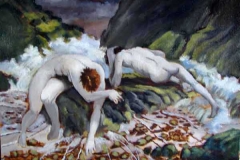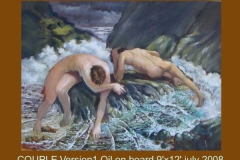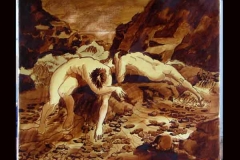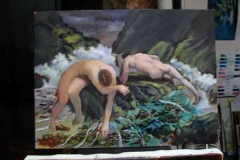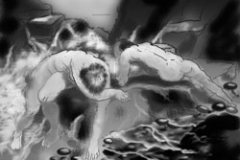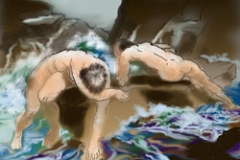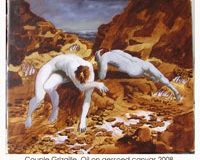When is a painting finished?
In an Atelier,the first block-in is called an ebauche..Usually executed quickly, it is frequently left in varying degrees of completion, not for aesthetic reasons, but because students simply dont have time to finish it, or because the particular problem the artist was concerned with has been solved, and they move on to the final version.
In the C19, students began to leave more and more of the ebauche unfinished.Following the example of Constable , Turner, Rembrandt , Hals, Rubens, Velasquez, and Titian, they were puzzled by the vivacity and spontaneity of “unfinished” work. To their professors, “finish” was an aesthetic and moral issue..
This debate stemmed from the “Poussinistes V Rubenistes” and the followers of Ingres and Delacroix who were really continuing a debate that started in C16 Italy between the Florentines and Venetians.
“Is drawing more important than colour? Should the designo be worked out first, or can the artist make changes in the working? Is the intellect and reason the basis of art or emotion and intuition? “ Do you want a 10 minute debate or pistols at dawn ?
By the C19, the debate had begun to focus on “finish” What that had come to mean was the softening of tonal transitions in order to heighten the illusion of reality, and reality didn’t have brushstrokes! The problem was, you could “finish” a painting to death, and lose other values such as spontaneity.Its good to note the debate was not clear cut. Alma-Tadema was criticised by his peers for relentlessly “finishing” everything in his paintings to the same degree, thus ignoring “the natural order of things”
The master artists above( particularly Velasquez)were such “painterly” artists they were able to make the brush mark an intrinsic part of the illusion. At a particular viewing distance it all “fell into place” Closer up, it all “fell apart”, leaving an experience a bit like sitting in the orchestra instead of the audience.
So French artists , as French artists do, began to insult each other. The young accused their professors as guilty of “licking their paintings clean”.(ie,removing brushmarks) Unpeturbed the older suggested that the young “ would finish their paintings if they finished their education”(ie showed some respect for hard work,craftsmanship and the buyer)
The Impressionists were influenced by photographic representation of movement and light, but we were not told till recently that Bougereau and Alma-Tadema also used photography. It is clear to me that Bougereau was imitating the brushless surface of photographed nudes, and beautiful it can be.In Young Girl and Love ,he has not only idealised the proportion, but the surface of the models skin.Finished to perfection! But surely, Monets broken rainbow haystacks are finished in the sense of being completely resolved, and clearly in the studio! That leaves us with at least two meanings for the idea of “finish”
In all the debate over Modernism , we have forgotten what the dilemnas were .In the current revival of the Atelier and of its teachings we have also inevitably revived its problems. “Finish” is still a technical, aesthetic and to some, a moral issue. Another issue probably more important is the issue of what to paint. The Impressionists rejected Godesses in favour of middle class nymphets in fashionable dress.Can we adopt C19 approaches to picture making without also reviving its debates and its flaws? Is a tattoo and a nose piercing enough contemporary relevance?
.To eliminate the brushmark with the sole purpose of heightening illusion is to seriously miss the point. “Take a photo!” is then, good advice.Painting to imitate the brushless surface of photography is a folly if that’s all it is.(.Incidentally, this has nothing to do with the old “painting from photographs” argument.I can think of no reason not to.)
But to leave the brushmark which becomes integral to the illusion requires much,much more.I am not precluding the blended stroke either. The hue,value ,chroma , shape, density ,etc etc of every brushmark must be “right”
If the “what to paint” had a political and class dimension so did the brushmark. The mark is a signature. Its personal and all the way to Jackson Pollock being promoted by the USA in the Cold War as a symbol of democratic individualism, its interpretation is deadly serious. It also is in danger of being tamed by the Atelier ethos. You may view this as a good thing. Too much narcissism today anyway. Or a bad thing, impinging upon your unfettered right to creative markmaking. But if you are threatened by it, you are in the wrong school.
We would not tolerate a violin concerto in which MOST of the notes are correct. In fact, the academy method was to develop the painting till almost finished then add those “finishing touches” of heartstopping bravura. Sargent was famous for it.
I am suggesting an extraordinary level of mastery here, an aspiration for atelier students,and in an important way, it doesn’t matter if it’s a painted pumpkin ,a rose or a nose. To those who don’t understand “viewing distance”, the capsicum might seem “unfinished” if we mistake “polish” or “detail”for “finish”. On the other hand , when is a painting “unfinished, not resolved, incomplete”? Whats the difference between a “painterly” pumpkin and a badly painted one? I am still working on it.
To really succeed, the Atelier movement ( and it seems to be global) needs to have high expectations, but equally an ability to articulate them. For its students, the conversation over lunch is as important as it was in Paris a century and a half ago, and its not finished.
Brian E Deagon
7/12/12
